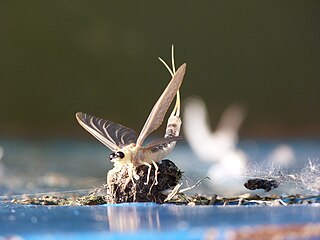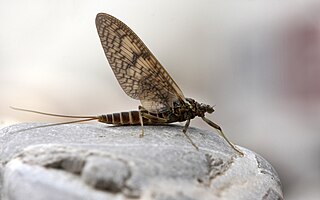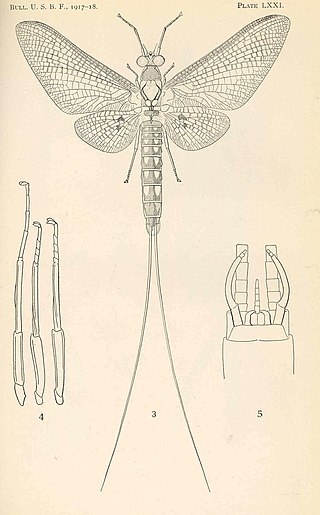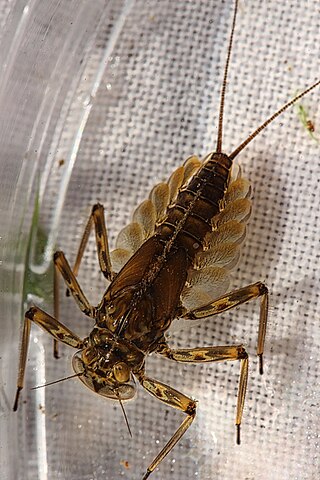
Mayflies are aquatic insects belonging to the order Ephemeroptera. This order is part of an ancient group of insects termed the Palaeoptera, which also contains dragonflies and damselflies. Over 3,000 species of mayfly are known worldwide, grouped into over 400 genera in 42 families.

Aquatic insects or water insects live some portion of their life cycle in the water. They feed in the same ways as other insects. Some diving insects, such as predatory diving beetles, can hunt for food underwater where land-living insects cannot compete.

The caddisflies, or order Trichoptera, are a group of insects with aquatic larvae and terrestrial adults. There are approximately 14,500 described species, most of which can be divided into the suborders Integripalpia and Annulipalpia on the basis of the adult mouthparts. Integripalpian larvae construct a portable casing to protect themselves as they move around looking for food, while Annulipalpian larvae make themselves a fixed retreat in which they remain, waiting for food to come to them. The affinities of the small third suborder Spicipalpia are unclear, and molecular analysis suggests it may not be monophyletic. Also called sedge-flies or rail-flies, the adults are small moth-like insects with two pairs of hairy membranous wings. They are closely related to the Lepidoptera which have scales on their wings; the two orders together form the superorder Amphiesmenoptera.
A rheophile is an animal that prefers to live in fast-moving water.

Ephemerellidae are known as the spiny crawler mayflies. They are a family of the order Ephemeroptera. There are eight genera consisting of a total 90 species. They are distributed throughout North America as well as the UK. Their habitat is lotic-erosional, they are found in all sizes of flowing streams on different types of substrates where there is reduced flow. They are even found on the shores of lakes and beaches where there is wave action present. They move by swimming and clinging, they are very well camouflaged. Most species have one generation per year. They are mostly collector-gatherers.

Leptophlebiidae is a family belonging to the Ephemeropterans that are commonly known as the prong-gilled mayflies or leptophlebiids. It is the only family in the superfamily Leptophlebioidea. There are around 131 genera and 640 described species. Leptophlebiids are easily recognized by the forked gills present on the larvae's abdomen, thus their common name.

Hipparchia fatua, or Freyer's grayling, is a butterfly of the family Nymphalidae. The species can be found from the Balkans, through Anatolia up to Iran.

Palingenia longicauda is an aquatic insect in the order Ephemeroptera. It is known as the Tisa or Tisza mayfly after the European Tisza river where it is found and also as the long-tailed mayfly and giant mayfly since it is the largest mayfly species in Europe, measuring 12 cm (4.7 in) from head to tail.

The Japanese sturgeon or Amur sturgeon is a species of fish in the family Acipenseridae found in the Amur River basin in China and Russia. Claims of its presence in the Sea of Japan need confirmation. The species has 11–16 dorsal, 34–47 lateral, and 7–16 ventral scutes. Their dorsal fins have 38–53 rays and 20–35 anal fin rays. They also have greyish-brown backs and pale ventral sides. The species can reach up to 3 metres (9.8 ft) in length, and weigh over 190 kilograms (420 lb). The species is considered to be critically endangered.

Rhithrogena germanica is a European species of mayfly, and is "probably the most famous of all British mayflies", because of its use in fly fishing. It is known in the British Isles as the March brown mayfly, a name which is used in the United States for a different species, Rhithrogena morrisoni. It emerges as a subimago at the end of winter, and can be distinguished from similar species by a dark spot on the femur of each leg.

Cloeon dipterum is a species of mayfly with a Holarctic distribution. It is the most common mayfly in ponds in the British Isles and the only ovoviviparous mayfly in Europe. Males differ from females in having turbinate eyes.

Leptosia alcesta, the African wood white or flip flop, is a butterfly of the family Pieridae, found in Africa.

Coxoplectoptera or "chimera wings" is an extinct order of stem-group mayflies containing one family, Mickoleitiidae.

Hexagenia bilineata is a species of mayfly in the family Ephemeridae. It is native to North America where it is found in the Upper Mississippi Valley. Sometimes adults of this mayfly are so abundant as to cause a nuisance because of their enormous numbers. The larvae are aquatic and burrow in mud and the adult insects have brief lives.

Prosopistomatidae is a family of mayflies. There is one extant genus, Prosopistoma, with several dozen species found across Afro-Eurasia and Oceania. They are noted for their unusual beetle-shaped larvae, which live beneath rocks and stones along the gravelly lower reaches of rivers. Their ecology is unclear, but they are probably carnivorous. They are closely related to Baetiscidae, with both families being placed in the Carapacea.

Epeorus vitreus is a species of flatheaded mayfly in the family Heptageniidae. It is found in southeastern Canada and the eastern United States.
Epeorus dispar is a species of flatheaded mayfly in the family Heptageniidae. It is found in North America.

Epeorus fragilis is a species of flatheaded mayfly in the family Heptageniidae. It is found in North America.
Epeorus longimanus is a species of flatheaded mayfly in the family Heptageniidae. It is found in North America.

Epeorus pleuralis, the quill gordon, is a species of flatheaded mayfly in the family Heptageniidae. It is found in North America.
















